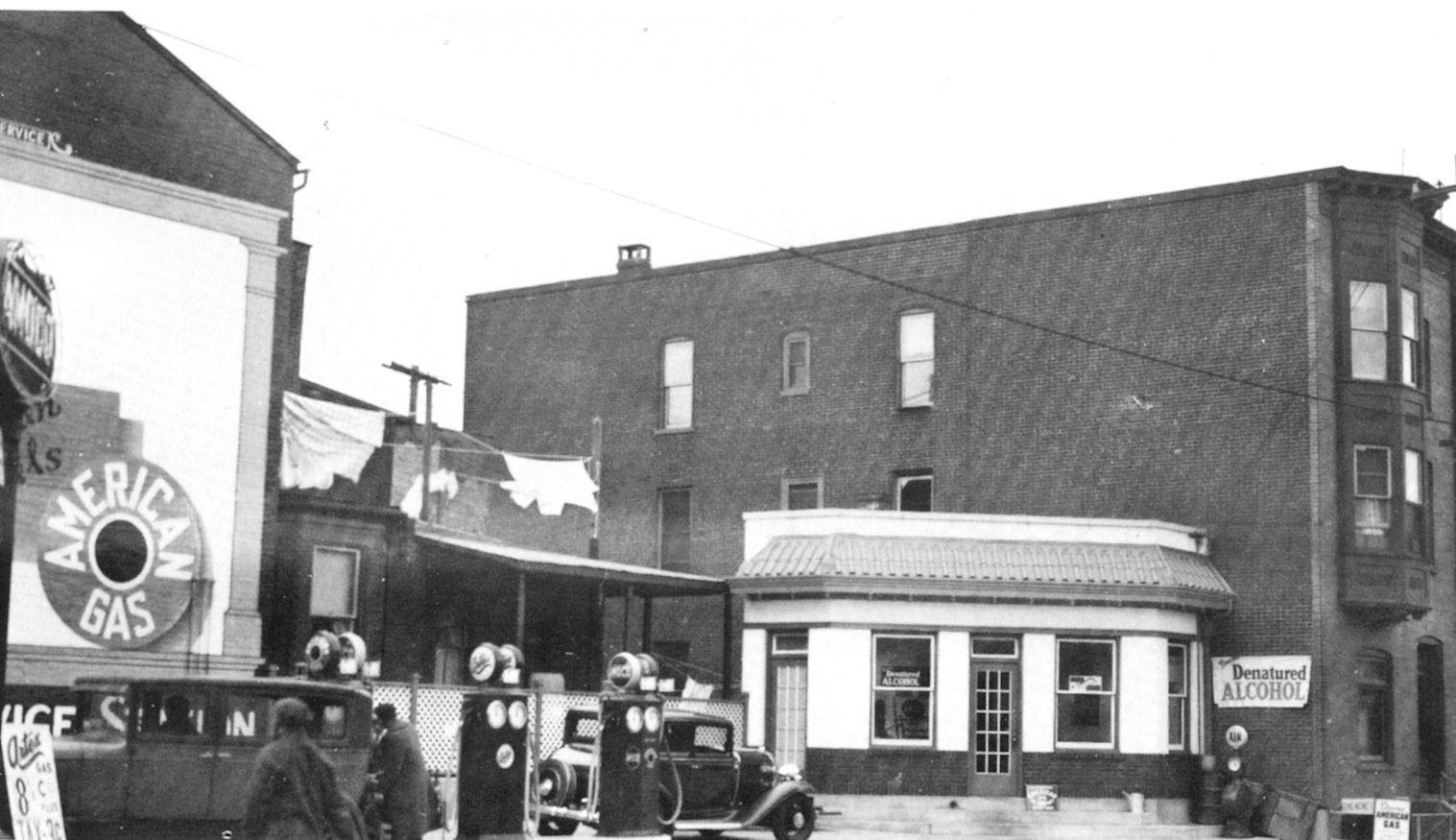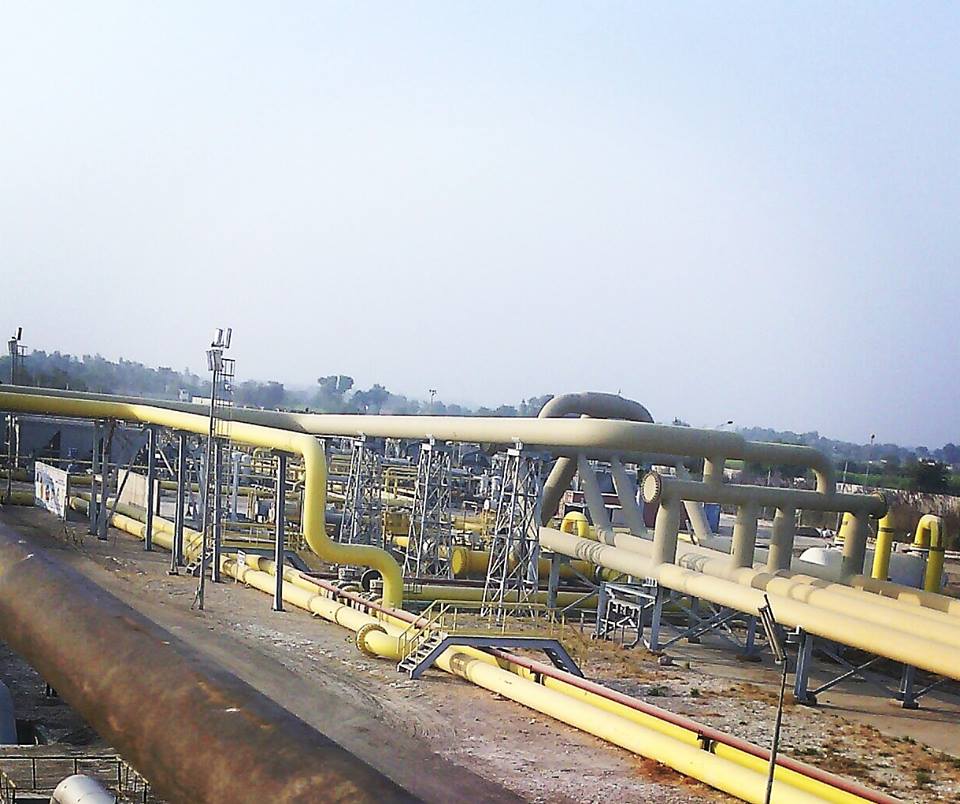|
Bacton Gas Terminal
The Bacton Gas Terminal is a complex of six gas terminals within four sites located on the North Sea coast of North Norfolk in the United Kingdom. The sites are near Paston and between Bacton and Mundesley; the nearest town is North Walsham. The other main UK gas terminals which receive gas from the UK continental shelf are at St Fergus, Aberdeenshire; Easington, East Riding of Yorkshire; Theddlethorpe, Lincolnshire; CATS Terminal, Teesside; and Rampside gas terminal, Barrow, Cumbria. History The Bacton complex which covers an area of about 180 acres (73 ha) opened during 1968. It has a frontage of 1 km (3200 feet) along the cliff top. It was initially built by Shell-Esso, Phillips Petroleum-Arpet Group, Amoco-Gas Council. Planning permission had been given on 16 June 1967 by Anthony Greenwood, Baron Greenwood of Rossendale. The Leman field began production on 13 August 1968 (joint Shell-Esso and joint Amoco-Gas Council), the Hewett field (Phillips Petroleum-Arpet Group) ... [...More Info...] [...Related Items...] OR: [Wikipedia] [Google] [Baidu] |
Bacton, Norfolk
Bacton is a village and civil parish in Norfolk, England. It is on the Norfolk coast, some south-east of Cromer, north-west of Great Yarmouth and north of Norwich. Besides the village of Bacton, the parish includes the nearby settlements of Bacton Green, Broomholm, Keswick and Pollard Street. It also includes Edingthorpe, which was added to Bacton civil parish under the County of Norfolk Review Order, 1935. The seaside village, whose name is derived from 'Bacca's farm/settlement', is located on the North Norfolk coast between Mundesley (a blue flag beach) and Walcott, Norfolk. Bacton is known for its very quiet sandy beaches offering miles of walking along the beach and cliffs. The England Coast Path passes through the village and also the Paston Way long-distance footpath linking Cromer and North Walsham. In the east of the parish can be found the ruined Cluniac Bromholm Priory. The civil parish has an area of and in the 2001 census had a population of 1,130 in 474 house ... [...More Info...] [...Related Items...] OR: [Wikipedia] [Google] [Baidu] |
Phillips Petroleum Company
Phillips Petroleum Company was an American oil company incorporated in 1917 that expanded into petroleum refining, marketing and transportation, natural gas gathering and the chemicals sectors. It was Phillips Petroleum that first found oil in the North Sea on December 23, 1969, at a position that was later named Ekofisk. On August 30, 2002, Conoco Inc. merged with Phillips Petroleum to form ConocoPhillips, becoming the third largest integrated energy company and second-largest refining company in the United States. The company moved its headquarters to Houston.Christopher J. Castaneda,"Phillips Petroleum Company." ''Encyclopedia of Oklahoma History and Culture''.Accessed 04 February 2013. In 2012, ConocoPhillips split into two separate companies. The legacy company kept its name, and spun off the midstream and downstream portions of its business. The new company, which owns the refinery, chemical and pipeline assets formerly held in ConocoPhillips, is named Phillips 66, the bra ... [...More Info...] [...Related Items...] OR: [Wikipedia] [Google] [Baidu] |
Tullow Oil
Tullow Oil plc is a multinational oil and gas exploration company founded in Tullow, Ireland, with its headquarters in London, United Kingdom. The company is listed on the London Stock Exchange and is a constituent of the FTSE 250 Index. History The company was founded by Aidan Heavey in 1985, in Tullow, Ireland, as a gas exploration business operating in Senegal. Tullow listed its shares on the London Stock Exchange and Irish Stock Exchange in 1986 and the FTSE 100 index in September 2007. In 2000, Tullow acquired £201 million worth of gas fields and infrastructure in the North Sea from BP. At the same time, Tullow re-registered in the UK. In May 2004, Tullow completed the Energy Africa acquisition for $570 million. In 2006, the company began drilling its first well in Uganda and began exploiting the Lake Albert region. In 2007, Tullow drilled two deep water wells offshore Ghana, discovering the massive Jubilee Oil Field. In February 2010, the company initiate ... [...More Info...] [...Related Items...] OR: [Wikipedia] [Google] [Baidu] |
Amoco
Amoco () is a brand of fuel stations operating in the United States, and owned by BP since 1998. The Amoco Corporation was an American chemical and oil company, founded by Standard Oil Company in 1889 around a refinery in Whiting, Indiana, and was officially the Standard Oil Company of Indiana until 1985. Originally part of the Standard Oil Company trust, it focused on producing gasoline for the new automobile market. In 1911, as part of the break-up of the Standard Oil trust, it became an independent corporation. Incorporated in Indiana, it was headquartered in Chicago, and formally adopted the name Amoco in 1985. Although the Amoco Corporation merged in 1998 into BP Amoco, the Amoco name was resurrected in 2017 as a brand that service station owners could choose to use when they purchased supplies from BP in selected areas of the United States. In 1925, Standard Oil of Indiana absorbed the American Oil Company, founded in Baltimore in 1910, and incorporated in 1922, by Lou ... [...More Info...] [...Related Items...] OR: [Wikipedia] [Google] [Baidu] |
Pounds Per Square Inch
The pound per square inch or, more accurately, pound-force per square inch (symbol: lbf/in2; abbreviation: psi) is a unit of pressure or of stress based on avoirdupois units. It is the pressure resulting from a force of one pound-force applied to an area of one square inch. In SI units, 1 psi is approximately equal to 6895 Pa. Pounds per square inch absolute (psia) is used to make it clear that the pressure is relative to a vacuum rather than the ambient atmospheric pressure. Since atmospheric pressure at sea level is around , this will be added to any pressure reading made in air at sea level. The converse is pounds per square inch gauge (psig), indicating that the pressure is relative to atmospheric pressure. For example, a bicycle tire pumped up to 65 psig in a local atmospheric pressure at sea level (14.7 psi) will have a pressure of 79.7 psia (14.7 psi + 65 psi). When gauge pressure is referenced to something other than ambient atmospheric pressure, then the u ... [...More Info...] [...Related Items...] OR: [Wikipedia] [Google] [Baidu] |
North Walsham Railway Station
North Walsham railway station (formerly known as North Walsham Main) is on the Bittern Line in Norfolk, England, serving the town of North Walsham. It is down the line from , between to the south and to the north. The station is managed by Greater Anglia, which also operates all passenger trains that call. Description Historically, the town was served by two adjacent railway stations; this existing station dating from 1874 served the Great Eastern Railway from Norwich to Cromer High, while a nearby station named served the former lines to (either via or via and ) and (via ). North Walsham Town closed on 28 February 1959, with the "Main" station renamed simply "North Walsham". In 2010 the station signs were changed to read "North Walsham, home of Paston College". The station is the site of the only passing loop on the route (although trains can also pass in the station at ), which has been worked remotely from Norwich since the line was re-signalled in 2000. The stat ... [...More Info...] [...Related Items...] OR: [Wikipedia] [Google] [Baidu] |
British Pipeline Agency
British Pipeline Agency Ltd (BPA) is a joint venture, established in 1969, between BP Oil UK and Shell UK. The company operates the UK oil pipeline network of oil pipelines which transport petroleum products around the UK. Operations BPA replaced the pipeline operations group of Shell Mex & BP in the late 1960s and took over the role as the majority operator on the Government Pipeline and Storage System (GPSS). As originally conceived the pipeline system comprised 1,600 miles of pipelines carrying 7.25 million tons a year of light oils, or 470 million ton miles annually. GPA continued as the major operator of the GPSS under reimbursable and fully indemnified contracts until the 1990s when those contracts were ended and the GPSS was instead operated by a number of companies under competitively tendered term contracts. The pipelines currently operated by BPA are: The company The BPA Board comprises five Directors, although the Articles of Association allows for up to te ... [...More Info...] [...Related Items...] OR: [Wikipedia] [Google] [Baidu] |
Amine Gas Treating
Amine gas treating, also known as amine scrubbing, gas sweetening and acid gas removal, refers to a group of processes that use aqueous solutions of various alkylamines (commonly referred to simply as amines) to remove hydrogen sulfide (H2S) and carbon dioxide (CO2) from gases. It is a common unit process used in refineries, and is also used in petrochemical plants, natural gas processing plants and other industries. Processes within oil refineries or chemical processing plants that remove hydrogen sulfide are referred to as "sweetening" processes because the odor of the processed products is improved by the absence of hydrogen sulfide. An alternative to the use of amines involves membrane technology. However, membrane separation is less attractive due to the relatively high capital and operating costs as well as other technical factors. Many different amines are used in gas treating: * Diethanolamine (DEA) * Monoethanolamine (MEA) * Methyldiethanolamine (MDEA) * Diisopropa ... [...More Info...] [...Related Items...] OR: [Wikipedia] [Google] [Baidu] |
Sour Gas
Sour gas is natural gas or any other gas containing significant amounts of hydrogen sulfide (H2S). Natural gas is usually considered sour if there are more than 5.7 milligrams of H2S per cubic meter of natural gas, which is equivalent to approximately 4 ppm by volume under standard temperature and pressure.NaturalGas.org website page ''Processing Natural Gas'' However, this threshold varies by country, state, or even agency or application. For instance, the considers a sour gas pipeline one that carries gas over 100 ppm by volume of H2S. However, the |
Triethylene Glycol
Triethylene glycol, TEG, or triglycol is a colorless odorless viscous liquid with molecular formula HOCH2CH2OCH2CH2OCH2CH2OH. It is used as a plasticizer for vinyl polymers. It is also used in air sanitizer products, such as "Oust" or "Clean and Pure". When aerosolized it acts as a disinfectant. Glycols are also used as liquid desiccants for natural gas and in air conditioning systems. It is an additive for hydraulic fluids and brake fluids and is used as a base for " smoke machine" fluid in the entertainment industry. Properties Triethylene glycol is a member of a homologous series of dihydroxy alcohols. It is a colorless, odorless and stable liquid with high viscosity and a high boiling point. Apart from its use as a raw material in the manufacture and synthesis of other products, TEG is known for its hygroscopic quality and its ability to dehumidify fluids. This liquid is miscible with water, and at standard atmospheric pressure (101.325 kPa) has a boiling point of 286.5 ... [...More Info...] [...Related Items...] OR: [Wikipedia] [Google] [Baidu] |
Slugcatcher
Slug Catcher is the name of a unit in the gas refinery or petroleum industry in which slugs at the outlet of pipelines are collected or caught. A slug is a large quantity of gas or liquid that exists in the pipeline. Slugs Pipelines that transport both gas and liquids together, known as two-phase flow, can operate in a flow regime known as slugging flow or slug flow. Under the influence of gravity, liquids will tend to settle on the bottom of the pipeline, while the gases occupy the top section of the pipeline. Under certain operating conditions gas and liquid are not evenly distributed throughout the pipeline, but travel as large plugs with mostly liquids or mostly gases through the pipeline. These large plugs are called slugs. Slugs exiting the pipeline can overload the gas/liquid handling capacity of the plant at the pipeline outlet, as they are often produced at a much larger rate than the equipment is designed for. Slugs can be generated by different mechanisms in a pip ... [...More Info...] [...Related Items...] OR: [Wikipedia] [Google] [Baidu] |
Standard Conditions For Temperature And Pressure
Standard temperature and pressure (STP) are standard sets of conditions for experimental measurements to be established to allow comparisons to be made between different sets of data. The most used standards are those of the International Union of Pure and Applied Chemistry (IUPAC) and the National Institute of Standards and Technology (NIST), although these are not universally accepted standards. Other organizations have established a variety of alternative definitions for their standard reference conditions. In chemistry, IUPAC changed its definition of standard temperature and pressure in 1982: * Until 1982, STP was defined as a temperature of 273.15 K (0 °C, 32 °F) and an absolute pressure of exactly 1 atm (101.325 kPa). * Since 1982, STP has been defined as a temperature of 273.15 K (0 °C, 32 °F) and an absolute pressure of exactly 105 Pa (100 kPa, 1 bar). STP should not be confused with the standard state com ... [...More Info...] [...Related Items...] OR: [Wikipedia] [Google] [Baidu] |



